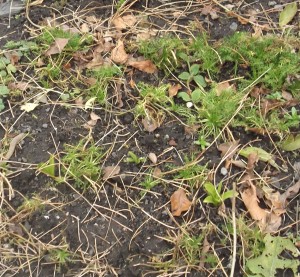 The chamomile lawn looks like this just now, a little bit battered, and very small. But considering it was only one plant when I got it, I don’t feel too bad about it. There are tulips coming through, and some madonna lilies, which apparently like to have their roots shaded, so I hope they will be happy here, and actually flower, for a change. I’ve cut back all the dead growth, but found that a lot of it was runners, like strawberry runners, with baby chamomile plants appearing at the nodes, so I’ve potted them up, as you see here.
The chamomile lawn looks like this just now, a little bit battered, and very small. But considering it was only one plant when I got it, I don’t feel too bad about it. There are tulips coming through, and some madonna lilies, which apparently like to have their roots shaded, so I hope they will be happy here, and actually flower, for a change. I’ve cut back all the dead growth, but found that a lot of it was runners, like strawberry runners, with baby chamomile plants appearing at the nodes, so I’ve potted them up, as you see here.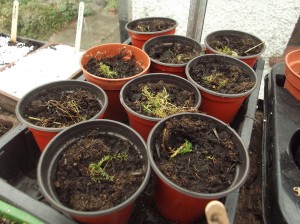 Some of them look a bit fragile, but it’s plants for free, so any success will be a bonus! The lawn will be mulched with compost, to feed it, but also to improve the soil structure. We didn’t have too wet a winter, but the last month has left the garden cold, heavy and sodden.
Some of them look a bit fragile, but it’s plants for free, so any success will be a bonus! The lawn will be mulched with compost, to feed it, but also to improve the soil structure. We didn’t have too wet a winter, but the last month has left the garden cold, heavy and sodden.
How bad this was I didn’t realise until I started work on the culinary patch. It looked like this in May last year: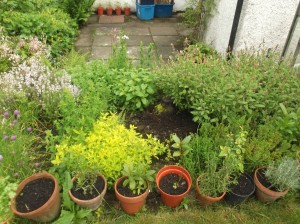 but now it looks like this:
but now it looks like this: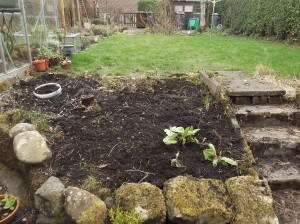 The reason is this little beauty,
The reason is this little beauty,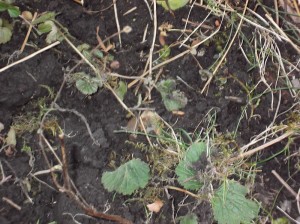 water avens (geum rivale). This first appeared in the field beside the river, then sneaked its way into my garden, where it seeded itself lavishly among the mulleins and hyssops. It’s a surprisingly sophisticated, delicate little flower in yellow and pink, and I was harbouring it under the illusion that it was its relative, the wood avens (also known as herb bennet) which has a fragrant root you can use in pot pourri. However, water avens is a good plant for bees and butterflies, so quite valuable in its own way, only the clue is in the name. It likes it wet. All my mediterranean plants – planted on the top of a south facing bank, were sulking and fading away, and moss was taking over everything.
water avens (geum rivale). This first appeared in the field beside the river, then sneaked its way into my garden, where it seeded itself lavishly among the mulleins and hyssops. It’s a surprisingly sophisticated, delicate little flower in yellow and pink, and I was harbouring it under the illusion that it was its relative, the wood avens (also known as herb bennet) which has a fragrant root you can use in pot pourri. However, water avens is a good plant for bees and butterflies, so quite valuable in its own way, only the clue is in the name. It likes it wet. All my mediterranean plants – planted on the top of a south facing bank, were sulking and fading away, and moss was taking over everything.
So the water avens has moved beside the pond, and the culinary patch was cleared. A barrow of compost was put on, and all the moisture lovers – the sorrel, mint lemon balm and chives, have been moved to the lower side. The top layer will be opened up, some sharp sand and compost added, and new plants of sage, oregano, thyme and winter savory will go in. I’ll sow chervil in the gaps, where I hope it will seed itself in the small crannies.
This all meant a lot of traipsing past the pond with barrows of discarded plant material, and the frogs were not at all pleased.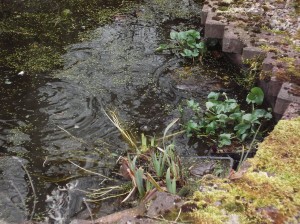 About twelve of them are croaking and mating furiously, and there are large lumps of spawn forming. Birds are chasing each other all over the garden too, and every time I go out there is something new to see – leaves on the gooseberry and blackcurrant, a violet, whose rich exotic purple just doesn’t show up in photographs, leaves of arum italicum, hellebore flowers, and the first flower bud on the wind anemones I planted from root cuttings two years ago. I can’t tell you how excited I am about this!
About twelve of them are croaking and mating furiously, and there are large lumps of spawn forming. Birds are chasing each other all over the garden too, and every time I go out there is something new to see – leaves on the gooseberry and blackcurrant, a violet, whose rich exotic purple just doesn’t show up in photographs, leaves of arum italicum, hellebore flowers, and the first flower bud on the wind anemones I planted from root cuttings two years ago. I can’t tell you how excited I am about this!